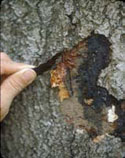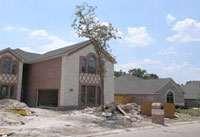Download PDF
PLPA-114
Understanding, Recognizing and Keeping Hypoxylon Canker of Oaks at Bay
| Part 1. Cause and BiologyHypoxylon canker is a tree disease appearing as a necrotic (dead) lesion on limbs, branches and trunks of affected trees. The canker develops just under the bark (Figure 1), but in advanced stages causes a white rot type of decay of the sapwood. For this reason, Hypoxylon canker not only contributes to tree mortality, but compromises the structural integrity of a tree making it a danger to life and property.
The disease is caused by a fungus named Biscogniauxia (Hypoxylon) atropunctatum. This fungus is an opportunistic pathogen, meaning it does not affect healthy and vigorous trees. However, Hypoxylon can quickly colonize weakened or stressed trees. It has been diagnosed on trees growing in many different habitats, such as forest sites, pastures, parks, green spaces and urban development areas. Hypoxylon canker can affect any type of oak, including; black, blackjack, laurel, live, post, southern red, Texas red, water and white oaks. |
Stress FactorsUrban development Many factors in urban environments stress trees. Construction damage, for example, wounds roots and causes site disruption that result in tree stress and decline. Constructing swimming pools, sidewalks, patios, and driveways can damage essential roots and root flares that provide necessary water and minerals for a healthy tree. Soil compaction and addition of fill soil cause
drainage issues and suffocate roots. All these factors set in motion a chain of events leading to stress, decline and tree death (Figure 2). During decline, |
Prepared by Sheila McBride1 and Dr. David Appel2
Diagnostician, Texas Plant Disease Diagnostic Laboratory1 and Professor of Plant Pathology and Microbiology2
Texas AgriLife Extension Service; The Texas A&M University System
May 22, 2009
The information given herein is for educational purposes only. References to commercial products or trade names are made with the understanding that no discrimination is intended and no endorsement by Texas AgriLife Extension Service personnel is implied.
Educational programs of the Texas AgriLife Extension Service are open to all people without regard to race, color, sex, disability, religion, age, or national origin.
The Texas A&M University System, U.S. Department of Agriculture, and the County Commissioners Courts of Texas Cooperating

